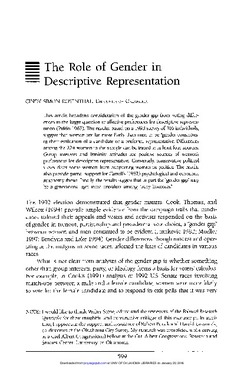| dc.contributor.author | Cindy Simon Rosenthal | |
| dc.date.accessioned | 2016-01-14T19:53:28Z | |
| dc.date.accessioned | 2016-03-30T15:36:35Z | |
| dc.date.available | 2016-01-14T19:53:28Z | |
| dc.date.available | 2016-03-30T15:36:35Z | |
| dc.date.issued | 1995-09-01 | |
| dc.identifier.citation | Rosenthal, C. S. (1995). The Role of Gender in Descriptive Representation. Political Research Quarterly, 48(3), 599-611. doi: 10.1177/106591299504800307 | en_US |
| dc.identifier.uri | https://hdl.handle.net/11244/25269 | |
| dc.description.abstract | This article broadens consideration of the gender gap from voting differ ences to the larger question of affective preferences for descriptive represen tation (Pitkin 1967). The results, based on a 1993 survey of 416 individuals, suggest that women are far more likely than men to be "gender conscious" in their evaluation of a candidate or a preferred representative. Differences among the 224 women in the sample can be traced to at least four sources. Group interests and feminist attitudes are positive sources of women's preferences for descriptive representation. Conversely, conservative political views deter some women from supporting women in politics. The results also provide partial support for Carroll's (1987) psychological and economic autonomy thesis. Finally, the results suggest that in part the "gender gap" may be a generational gap most prevalent among "baby boomers." | en_US |
| dc.language.iso | en_US | en_US |
| dc.publisher | Political Research Quarterly | |
| dc.title | The Role of Gender in Descriptive Representation | en_US |
| dc.type | Research Article | en_US |
| dc.description.peerreview | Yes | en_US |
| dc.description.peerreviewnotes | https://us.sagepub.com/en-us/nam/manuscript-submission-guidelines | en_US |
| dc.identifier.doi | 10.1177/106591299504800307 | en_US |
| dc.rights.requestable | false | en_US |
